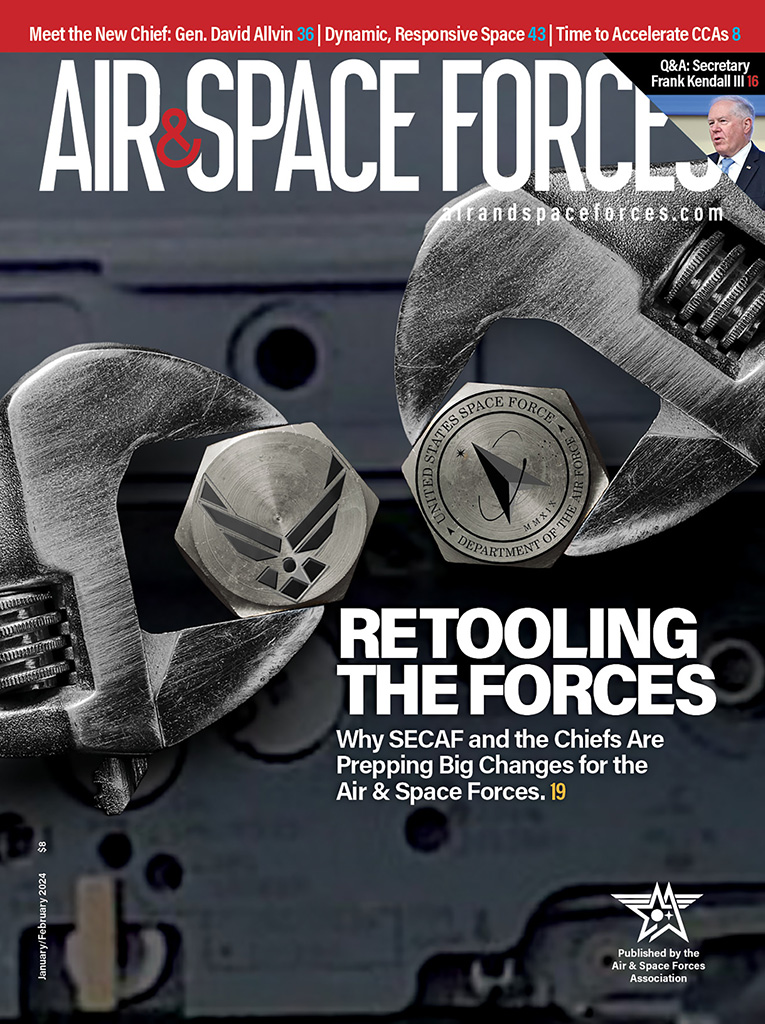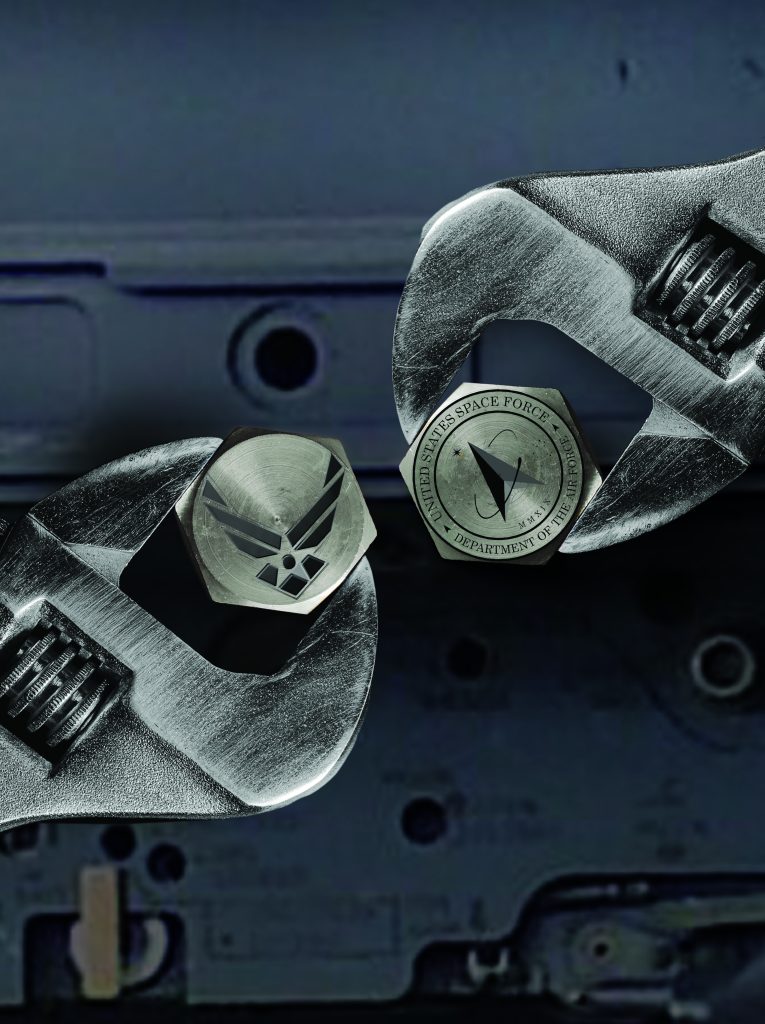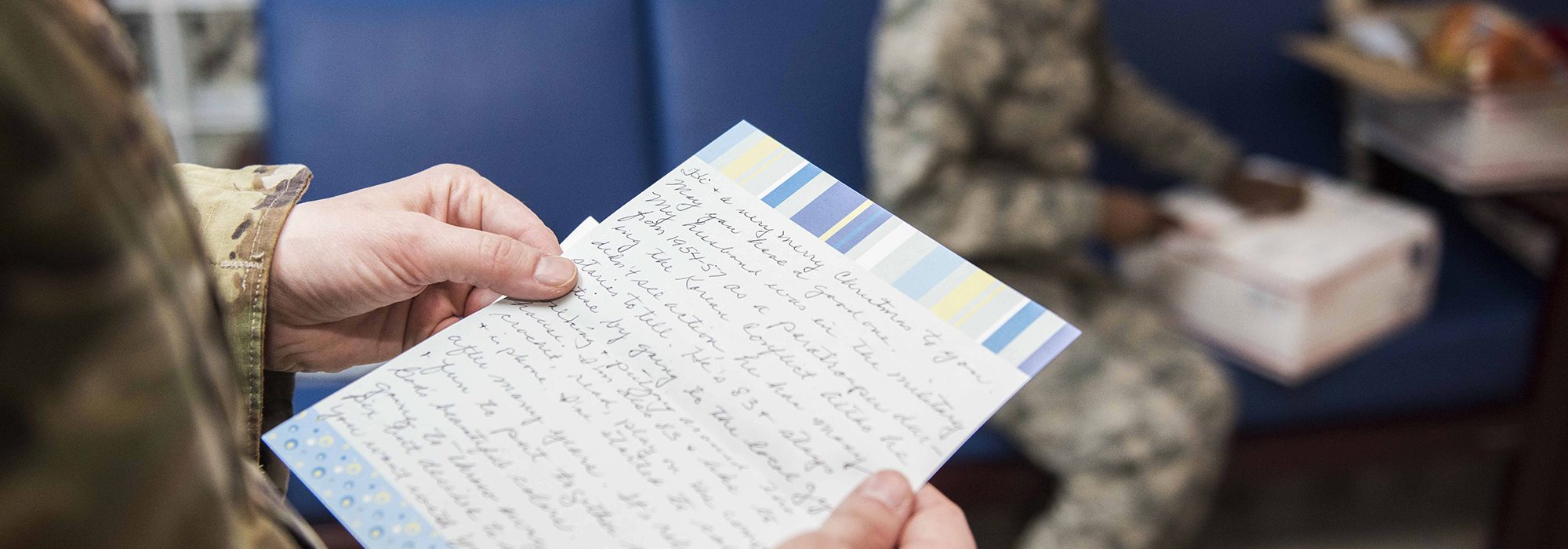We love letters! Write to us at letters@afa.org. To be published, letters should be timely, relevant and concise. Include your name and location. Letters may be edited for space and the editors have final say on which are published.
Alert Status
The article “Extending Endurance for Pacific Conflict” [January/February, p. 40] generated a lot of concern for me. Nowhere in the article was there a mention of the use by Air Mobility Command of highly effective, predictive modeling of fatigue effects. It was a Brooks City-Base, Texas (formerly Brooks Air Force Base) research division of the Air Force Research Laboratory (AFRL) that developed the Fatigue Avoidance Scheduling Tool (FAST) software from the Army’s Safety, Alertness, Fatigue, and Task Effectiveness (SAFTE) model. That division of AFRL is now the 711th Human Performance Wing, mentioned in the article.
I suspect that the cause of the omission of the use of predictive modeling is the loss of institutional knowledge that occurred when the AFRL division’s branches at Brooks were closed in 2007.
The SAFTE model and FAST software were used by Dr. Bill Storm of AFRL to help B-2 crews deal with their 33- and 44-hour missions. I used SAFTE/FAST in numerous fatigue consults with operational USAF units. In addition to SAFTE/FAST, there are other carefully developed and useful fatigue and sleep prediction models available: the Sleep/Wake Predictor Model, Sweden; the System for Aircrew Fatigue Evaluation Model (SAFE) U.K.; the Fatigue Audit InterDyne Model (FAID), Australia; and the Circadian Alertness Simulator Model (CAS), Harvard.
Models such as these need to be used not only to help aircrews, but also to help the operations and maintenance personnel who work 24/7 to keep the aircrews and aircraft functioning effectively. A multitude of cases have been documented in which fatigue-induced poor decision-making has led to calamities in all transportation modes and in 24/7 control rooms and maintenance. Fatigue modeling needs to be in the fatigue management toolbox.
Maj. James C. Miller,
USAF (Ret.)
Corpus Christi, Texas
Air Force Standards
I applaud Airman Hayden Perez’s gumption for formally offering his opinion on male grooming standards in today’s Air Force [“Letters: Grooming,” January/February, p. 4]. It’s one thing to chat about it in the workplace or over lunch but quite another to compose an opinion piece destined for this fine magazine and the Chief Master Sergeant of the Air Force’s social media page as well.
Airmen have been challenging Air Force dress and appearance standards since Gen. Carl “Tooey” Spatz took exception to one of his admin clerk’s haircuts back in our early days.
In the 1970s I was a young enlisted man. We questioned limits on hair and sideburn length and moustache width. Like many of my enlisted contemporaries, I protested by trying to game the system at every turn.
Later as a technical sergeant, my senior master sergeant supervisor took me aside and told me that his boss, Capt. K., said I needed to trim my moustache. It had been almost as obvious as the nose on my face for months that the ends of my ’stache were past the vermilion of my mouth. I worked in a well-traveled administrative area, yet the fact that it took an Air Force officer to point it out speaks volumes of the attitudes at the time.
That said, we didn’t have failure “to promote an inclusive environment” to hang our hats on back then. It was all about just trying to look like a civilian when off-duty.
Airman Perez states that, “current restrictions on hair length and the prohibition of earrings for men appear inconsistent with the principles of equality and diversity embraced by the Air Force.” He opines that today’s grooming standards are outdated, discriminatory, stereotypical, prejudicial and disrespectful. Today’s standards just don’t fare well against today’s “contemporary values.” That’s code for I just want to look like a civilian. Then why did he enlist?
Airman Perez could get his wish. In our current environment anything is possible. That doesn’t make it appropriate or in the best interest of the Air Force. Whatever happened to maintaining “good order and discipline” or is that an outdated concept as well?
Col. Bill Malec,
USAF (Ret.)
O’Fallon, Ill.
Airman Hayden Perez’s letter will no doubt receive significant replies from a host of officers and NCOs, both retired and active, and it should. Missing in Airman Perez’s statements about grooming standards, and his belief they should be relaxed, was any mention of Air Force mission goals and requirements. His entire focus was on diversity, as though that is an Air Force mission standard. Is it? I sincerely hope not, or else the Air Force has sadly lost its focus on warfighting, much less winning wars.
Air Force grooming standards, as they have existed since the foundation of the force, have been about warfighting. Shorter hair length makes grooming in the field, and wear of essential equipment, far easier and quicker. In basic training, whether for enlisted or officer candidates, there remains an emphasis on early rise and quick preparation for the duty day. This was to educate the young to prepare them for duty in the field, where sleep is a luxury, and duty days very long and arduous.
If nothing else, anyone who refused to accept this timeline identified themselves as someone who perhaps doesn’t belong in the Air Force.
This is because, in combat, there is an enemy out there dedicated to killing you, so they can secure victory through your defeat! To beat them and secure victory, our Airmen must perform better than them, must outlast them, and must defeat them.
The mission of the Air Force is to fly, fight, and win. It is not to engage in diversity sessions focused on creating different standards of personal grooming in the interest of placating a myriad of diverse cultural standards. Given this Airman’s rank, one must surmise he has about six months of total service experience. He seems to have much to learn.
Perhaps reading the replies of many officers and NCOs, written largely by those who retired after careers that saw many combat deployments, might help him better understand the nature of his chosen profession.
Maj. Ken Stallings,
USAF (Ret.)
Douglasville, Ga.
Reading the letter by Airman Perez on the state of grooming standards has encouraged me to reminisce on my own experiences and maybe enlighten a younger generation on how bad life was under the old 35-10 oppression. I served as an RF-4 pilot at RAF Alconbury, U.K., from 1974-1976.
Being aware of 35-10 standards as a new second lieutenant pilot in USAFE was one thing, but experiencing the lengths of how this one regulation was used by command, was often career impacting, and many times comical.
The “no call, pilots brief.” Our esteemed wing commander called for an all-hands pilots standdown brief one afternoon. As we all sat in the large briefing room awaiting enlightenment, the wing commander slipped in the back door with pencil and paper and took notes on which pilots had hair out of limits. After he left, his deputy announced the meeting was over.
“The perils of the podium.” There was an all-day instrument class requiring all pilots to take a test and receive a certification for flying. I was encouraged to sign up as an instructor for OER (officer effectiveness report) fodder and command-level visibility. I had a one-hour block on Radar Precision Approaches. I did my thing for several days with one class having the wing commander in attendance. Several months later, I was briefed on my OER by my squadron commander. I noticed that my score on “Professional Qualities” was downgraded. When I asked why, my commander looked sheepish, and said when I taught at the instrument school several months prior, the wing commander noted that my sideburns weren’t the same length. They were within limits but not exactly the same length. Of course there was no way to challenge this, and my commander was directed to downgrade my OER.
“The great military clothing scandal.” Our military clothing sales were tucked in a corner of the exchange. On display was a mannequin modeling a Class A uniform with the rank of colonel. Then the Operational Readiness Inspection (ORI) descended upon us like a plague of locusts and stress. The way it came down was when a jet showed up on final and announced, “This is an ORI and you are now directed to execute.”
The inspection team went to work over the next week and left no stones unturned. When it came time to tear through the exchange, the base received a write-up that the clothing sales’ mannequin was modeling a uniform while the mannequin’s hair was out of 35-10 standards.
Now, our base barber shop had the poor mannequin’s head on the counter for a month while they tried to determine how to give him a 35-10 haircut. After the job was done, all the pilots took note that the mannequin was now on duty, but reduced in rank to an enlisted. The wing commander struck again.
And all this was happening as we routinely had pilots from Denmark stop by in their F-104s for an out and back cross-country jaunt. They’d show up at the Officers Club for lunch, sit down for a burger and we all noticed what nice ponytails they sported and thought, I can’t imagine what kind of pilots they must be with hair like that.
Col. Don Parden,
USAF (Ret.)
Indianapolis
The ABCs of It
The Air Force should buy an F-15EX for every F-15C and F-15E [being retired] and tell Boeing to generate them in at least 25-per-year lots.
A sufficient number of combat systems officers for the F-15EX to replace F-15E’s crew members should be trained and maintained as a career field. Settling on the two-seat configuration for the F-15EX would provide for the future unmanned force control.
As they are ready, replace the Cs and Es 1-for-1. The replaced jet going to Guard and Reserve units for rehab and upgrades. This will reduce the cost per unit and provide homeland defense/backup forces using the older jets.
All the Cs should receive A/G software and equipment to provide additional attack forces.
This will allow the F-35 community to perhaps fix their program-long ECS and engine problems, as well as address their landing accident rates.
Charles McCormack
Danville, Calif.
Military Living
There is another side of military life that I have never seen publicized and which I think could be a positive factor in recruiting. I’m referring to the benefits to family life. I spent 20 years as an Air Force pilot. I married just before going to Korea in 1952 and started family life upon my return in 1953. My first stateside station was Pinecastle Air Force Base near Orlando, Fla. While there we visited many of the tourist attractions in central Florida and fully enjoyed the Atlantic coast beaches.
My next assignment was McConnell Air Force Base in Wichita, Kan., which I’ll admit was a bit boring. We did visit a restored western town at Dodge City and even drove to the zoo in Oklahoma City. Meanwhile, we added two more children to our family for a total of three.
In 1959, we were transferred to Little Rock Air Force Base, Ark., and our first experience with on-base housing. It was great; a three-bedroom, two-bath ranch style home with all utilities paid (except phone) for my meager housing allowance of approximately $250. We bought a fiberglass boat with a 40-horse engine and picnicked and water-skied almost once a week for the five summers we were there. We also visited Hot Springs and the first-class entertainment there. We visited a large cave and spent several pleasant visits to Petit Jean Mountain, swimming and horseback riding.
In 1959 I was transferred to Castle Air Force Base in Merced, Calif., for B-52 training. Enroute to Castle, we stopped at Meteor Crater and the Grand Canyon, toured Hoover Dam, and spent a wonderful night in Las Vegas. From there, we went to Disneyland and Sea World of the Pacific before heading north to Merced. While at Castle, we lived in a brand-new apartment right next to the elementary school my children attended and were within sight of Yosemite National Park. We visited there and several other attractions to the north. We even drove through the General Sherman giant redwood tree seen on many postcards. We visited San Francisco, Fisherman’s Wharf, the Golden Gate Bridge, and Pebble Beach golf course. And, meanwhile I learned to fly the B-52.
My wife and family got to see the rest of the northern United States as we drove all the way to Loring Air Force Base in Maine. Loring was very isolated, but the folks we met both on and off base were warm and friendly and there was a beginners’ ski slope right on the base. We could rent skis, poles, and boots for only 25 cents a day. So, of course, we learned to ski. We actually made an ice rink in our backyard (on base housing) and ice-skated.
After 18 months at Loring, we were transferred to Plattsburgh Air Force Base, N.Y., another far northern base. That put us within a one-hour drive of some of the best skiing in the country. We visited Lake Placid, N.Y., where my two boys and I got to ride a bobsled down the Olympic bobsled run. WOW!!! What a thrill. And, we all skied on White Face Mountain, the same place that the Olympic skiers use, except we went a lot slower. During our four-our-and-a-half years there, we visited eastern Canada many times, saw the huge tides at the Bay of Fundy and shared a drink with Frankie Laine (for you younger folks, a very famous singer of the 1940s and ’50s.) at the Playboy Club in Montreal. Because of a labor shortage in the fall and winter, my wife and several of her friends helped the local apple growers harvest their crops. As a result, we met several influential local folks and actually got a guided tour through Expo 67 while it was under construction in Montreal.
Once at Plattsburgh, I asked the principal of my children’s school if I could take them on a week’s leave during regular school. We agreed and he told me that he had been very pleasantly surprised when he was assigned to the school on base. He believed that military children were not too bright, but soon learned that, instead, they were much better educated than most civilian children because they had traveled so much and seen so many things that other students only read about.
I retired from the Air Force in 1970 and people still thank me for my service and for my personal sacrifice. I thank them and, time permitting, tell them that it was no sacrifice. I enjoyed all of it. We have been places and done and seen things that most folks can only dream of. This is a part of military life that most people aren’t even aware of. The retirement pay is not bad either.
Lt. Col. Alfred J. D’Amario,
USAF (Ret.)
Hudson, Fla.
Undercover
An idea for defending our facilities against these drone attacks: erect a huge tent of material over the entire camp, perhaps using the material used for golf driving ranges, then cover that with something opaque.
The enemy would be unable to select aimpoints, it would provide shade and lower temperatures over the entire camp, and any type of cheap, small drone used to attack would likely be stuck up in the netting. Larger drones that could penetrate the netting would by nature have a larger signature and therefore be easily targetable by our defenses.
This is the same concept as the “cope cages” being used by both sides in the Ukraine conflict to defend against small drones. We should assume that any of our facilities in the Middle East or Africa could be attacked the same as Tower 22.
Please pass this on to whomever you think could act quickly on this. With a crash project involving our Red Horse Civil Engineering squadrons, we could protect all our vital facilities in a few months.
MSgt. Chris Dierkes,
106th Rescue Wing, NYANG
Westhampton Beach, N.Y.
Chief Tool Nerd
Well, well … after 40+ years of life membership I am writing my first letter to you fine folks—and it’s about wrenches.
Remember, always turn an adjustable wrench toward the adjustable jaw. I think your [January/February] cover page depicts otherwise.
Lt. Col. Norm Komnick,
USAF (Ret.)
Tacoma, Wash.
Editor’s note: Thanks for helping us tighten the screws!


Unit Reunion:
Former Oklahoma State University AFROTC Det. 670 Cadets, Angels, Arnies, and Silver Wings. Registration is now open for our reunion to be held May 3-5, 2024, on the OSU campus, Stillwater, Okla.
Register at: ORANGECONNECTION.org/det670 for more details.
Contact: www.det670@gmail.com.
